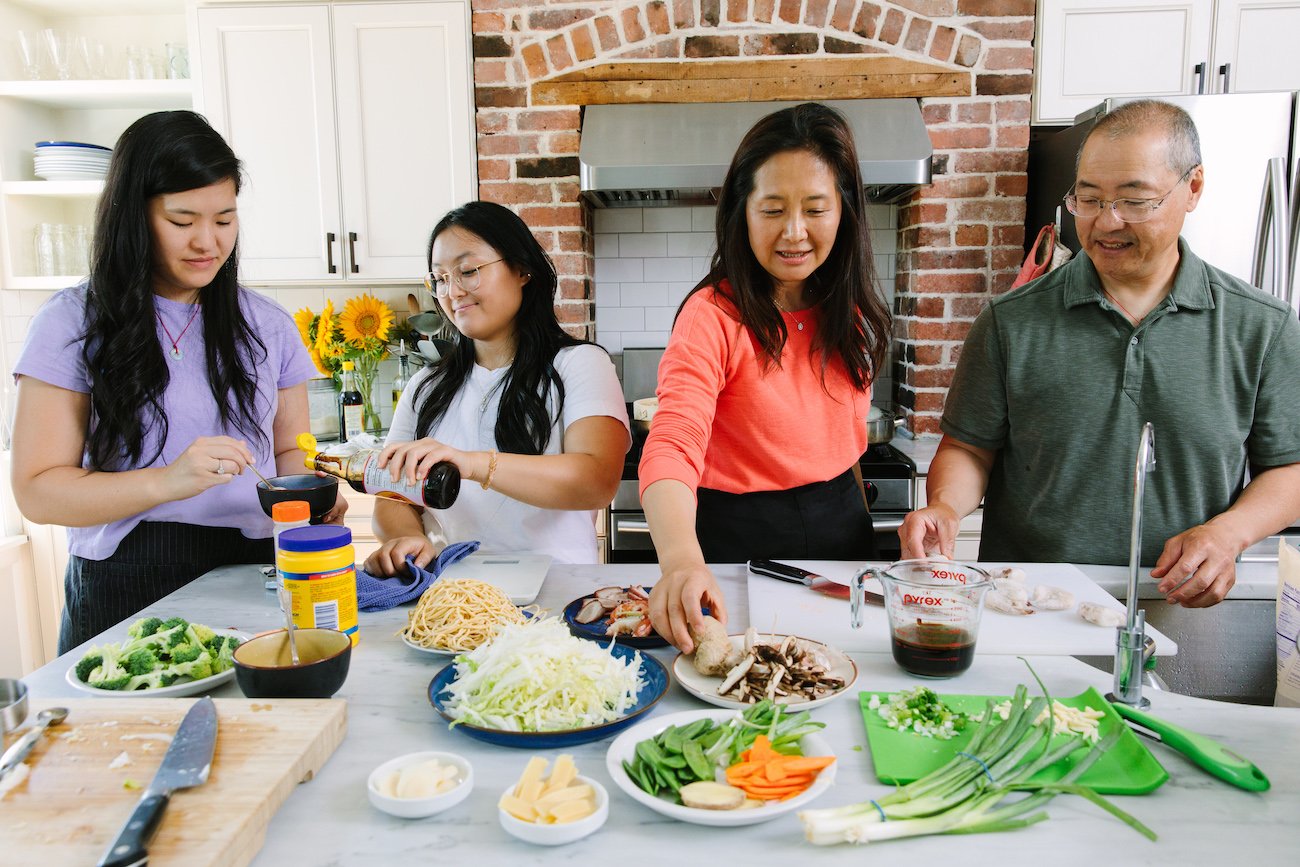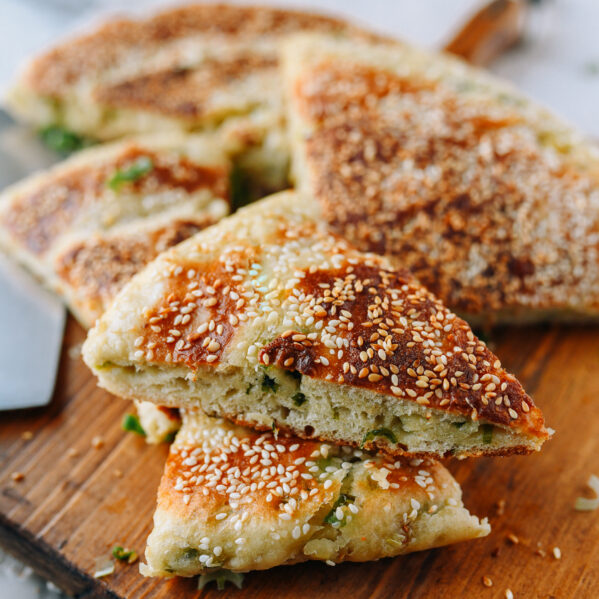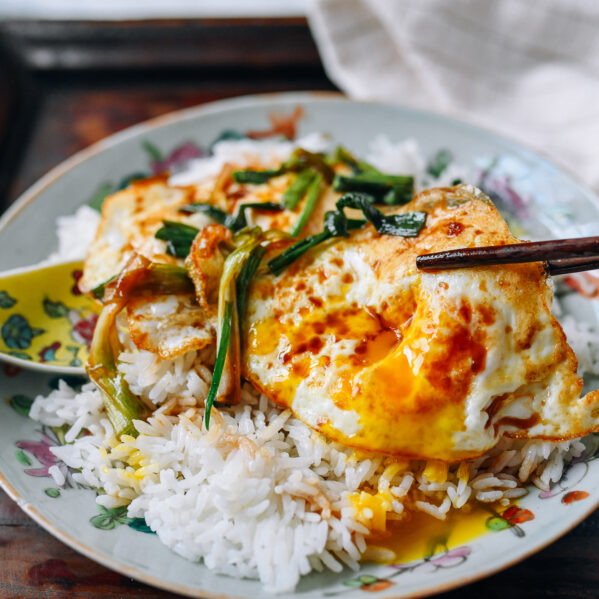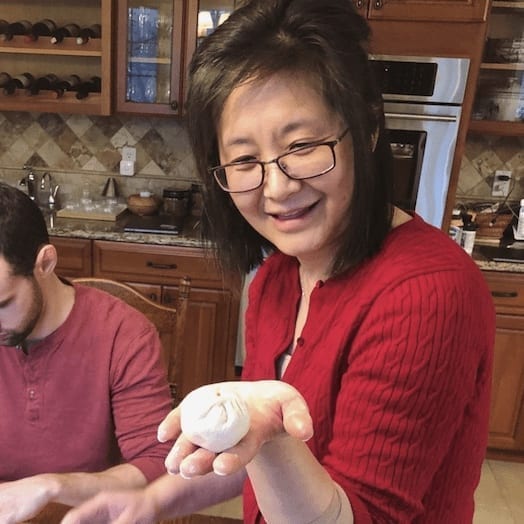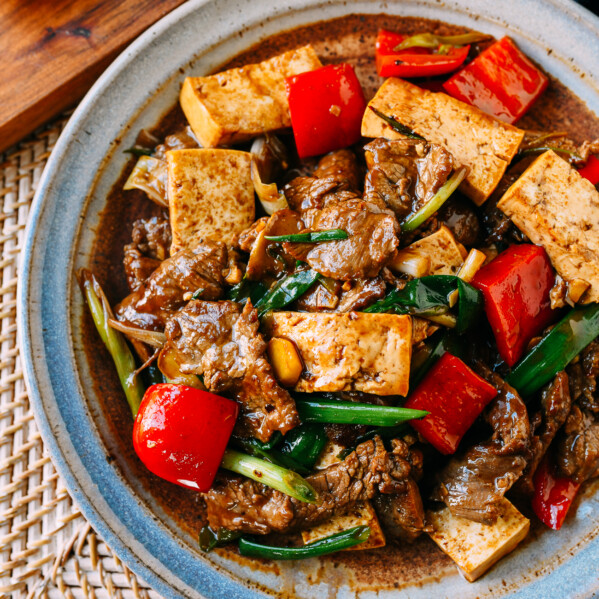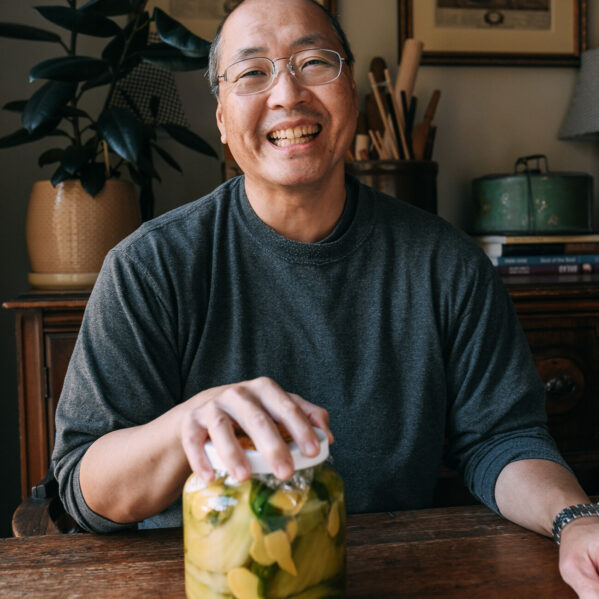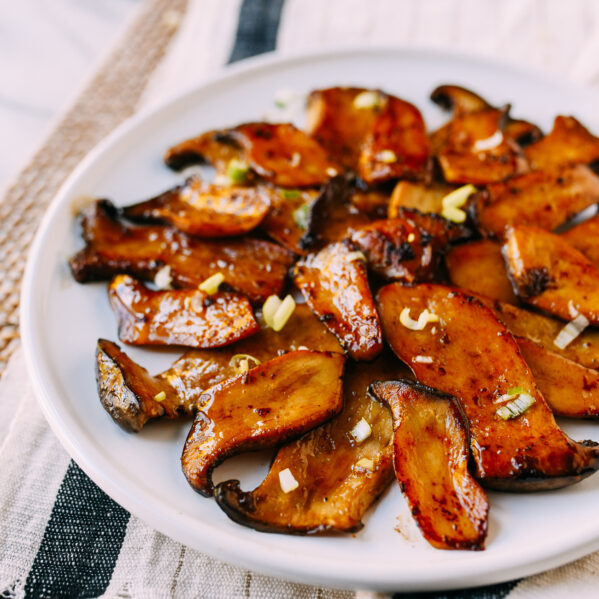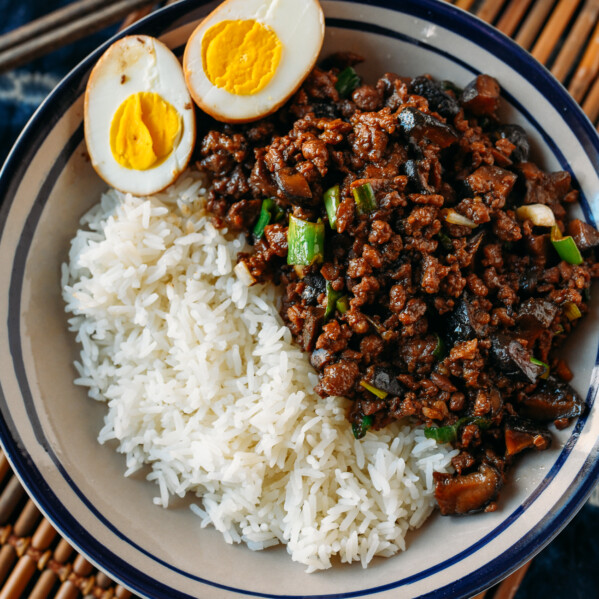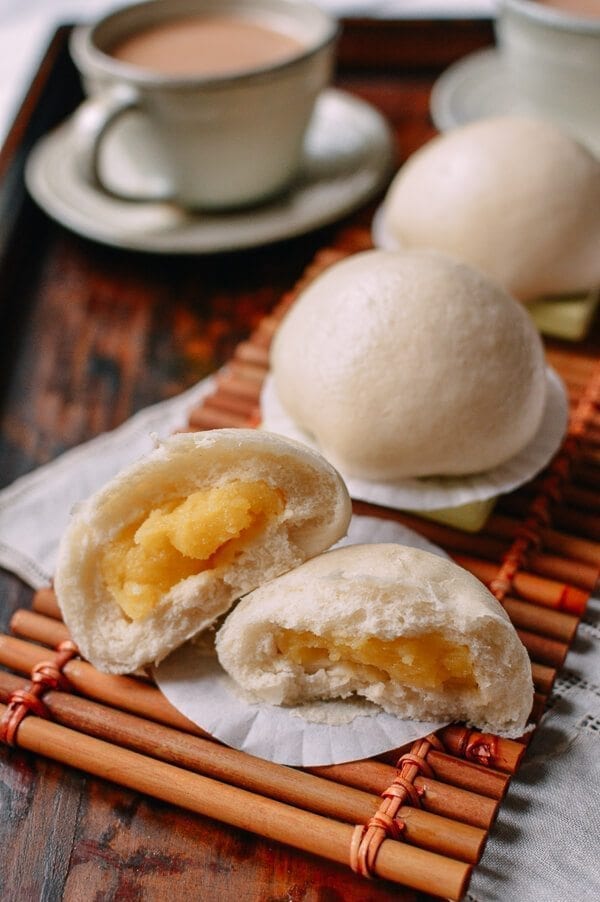
Some Background on This Recipe
Steamed Custard Buns are an absolute favorite on the dim sum carts. For many people, they really hit the spot. Holding that hot, delicate bun is like a passageway to childhood and countless sweet memories. Needless to say, this bun doesn’t require much introduction. Regarding more pressing, technical issues, I know I will get a lot of questions about the flour. In order to get that fluffy, baby-bottom-like texture, I used bleached flour. It’s not usually my choice, but for authenticity, I was overruled by the rest of the Woks of Life contributors. Feel free to use non-bleached flour, or whole wheat flour as a replacement for 1/3 of flour that the recipe asks for. Try not to use all whole wheat flour, as this will yield buns that are too dense.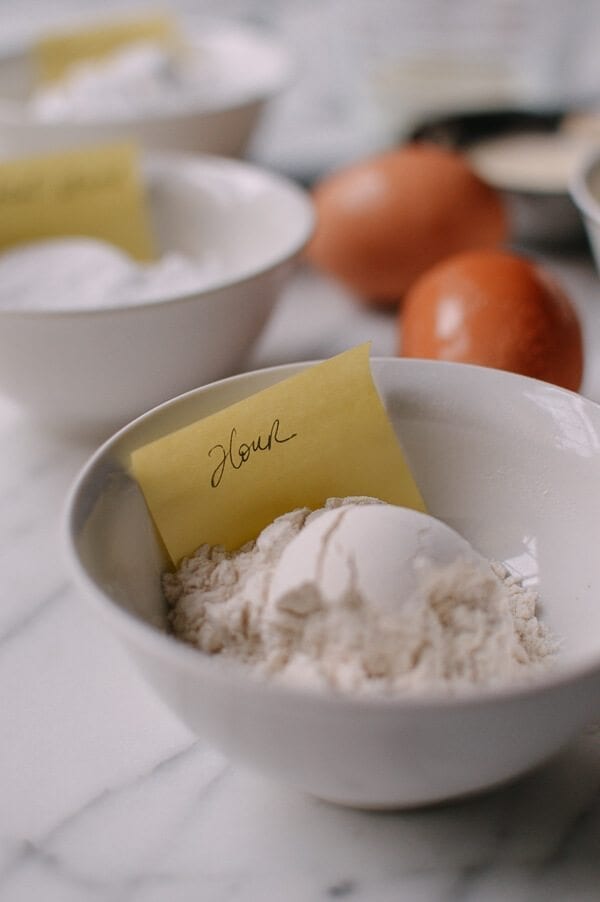 These days, with everyone becoming more health-conscious, foods are thought about more in terms of calories and health benefits, not as an indication of wealth like a Chanel bag or a Rolex watch. But in the old days, it was very much a social status gauge.
Poor people lived on unprocessed grains, while the rich dined on refined grains. That is, poor people ate pickled radishes with gruel while the rich noshed on their carnivorous feasts with soft steamed buns and white rice. Whenever I see these bleached white buns, it always reminds me this little facet of the past.
Since this nai wong bao custard bun has a sweet filling, I made the dough slightly sweet. I also added in some coconut milk. This may be a bit unusual, but it definitely added a depth of flavor and rich aroma—in other words, more personality!
Cooking tip: a hand-mixer or a stand mixer is particularly helpful in making the custard filling! Good old elbow grease will work, too, if you don’t have one.
These days, with everyone becoming more health-conscious, foods are thought about more in terms of calories and health benefits, not as an indication of wealth like a Chanel bag or a Rolex watch. But in the old days, it was very much a social status gauge.
Poor people lived on unprocessed grains, while the rich dined on refined grains. That is, poor people ate pickled radishes with gruel while the rich noshed on their carnivorous feasts with soft steamed buns and white rice. Whenever I see these bleached white buns, it always reminds me this little facet of the past.
Since this nai wong bao custard bun has a sweet filling, I made the dough slightly sweet. I also added in some coconut milk. This may be a bit unusual, but it definitely added a depth of flavor and rich aroma—in other words, more personality!
Cooking tip: a hand-mixer or a stand mixer is particularly helpful in making the custard filling! Good old elbow grease will work, too, if you don’t have one.
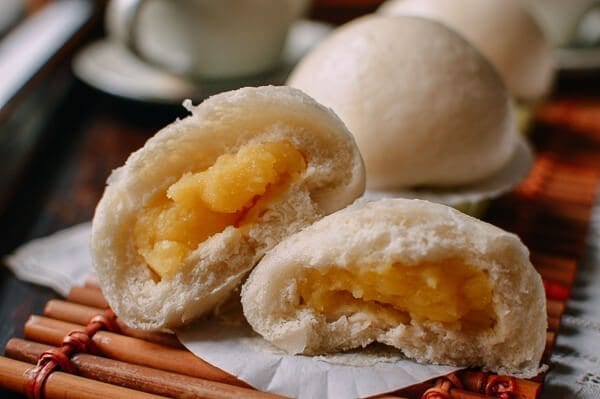 Here’s how to do it.
Here’s how to do it.
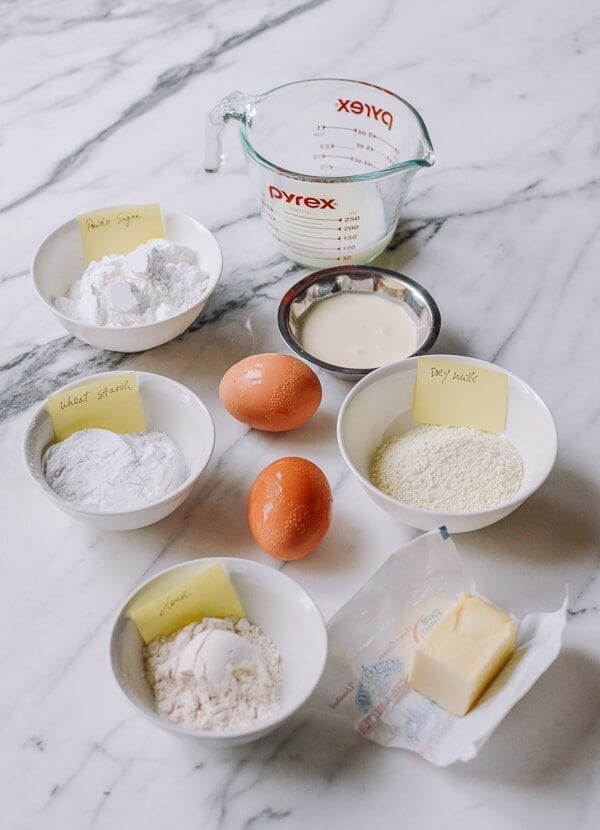
Recipe Instructions
Scroll down to the recipe card for full list of ingredients. Continue reading for detailed instructions with step-by-step photos. Start by making the filling. Heat some water in a medium to large, deep pot. The water should be about 2 inches deep, and the pan should be large enough to accommodate the mixing bowl. Once the water boils, turn the heat to down to a simmer. In a large heatproof bowl or the metal mixing bowl that came with your stand mixer, add the eggs and powdered sugar. Beat for a minute on low. Next, add the milk and heavy cream, and beat for a few seconds to combine.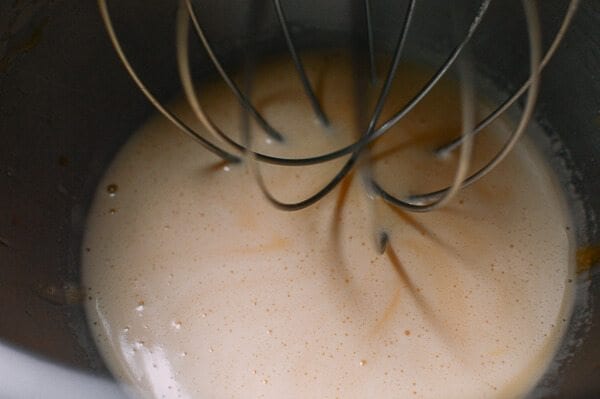 Then sift in the flour, wheat starch or cornstarch, and dried milk powder. Mix everything in until there are no lumps. Now add in the melted butter, and stir to combine.
Then sift in the flour, wheat starch or cornstarch, and dried milk powder. Mix everything in until there are no lumps. Now add in the melted butter, and stir to combine.
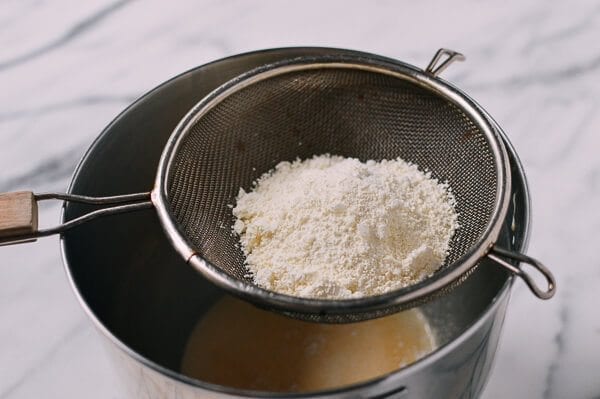
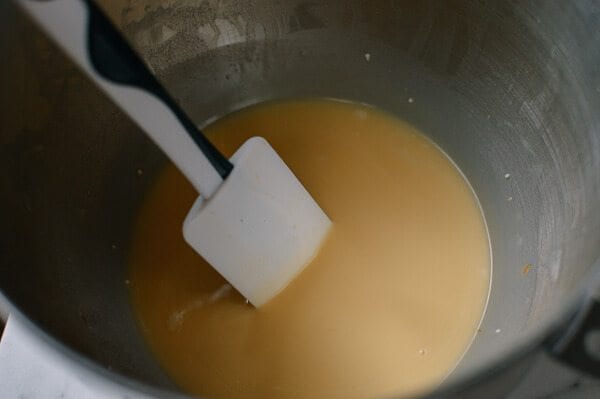 Next, carefully lower the mixing bowl into the pan of water, and begin stirring the mixture quickly and continuously.
Next, carefully lower the mixing bowl into the pan of water, and begin stirring the mixture quickly and continuously.
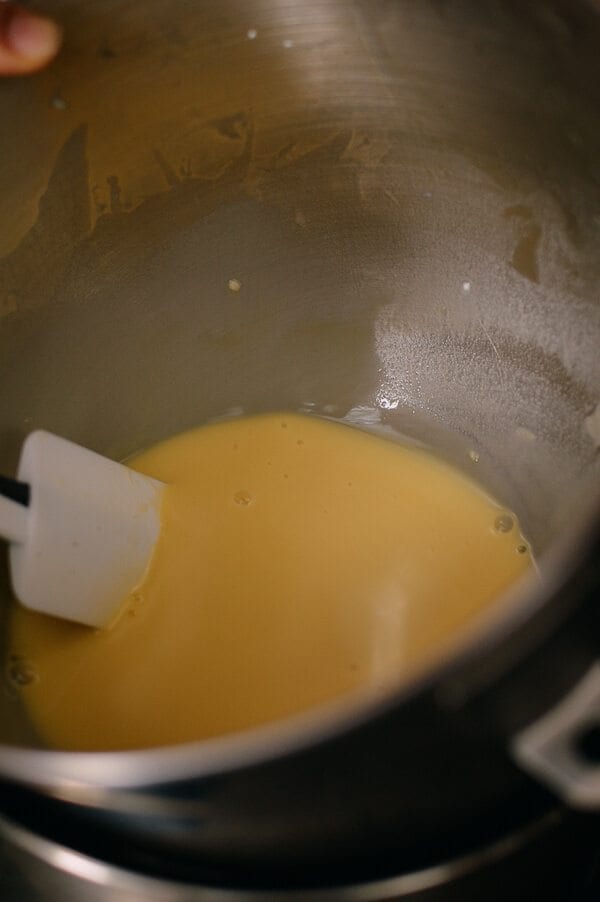
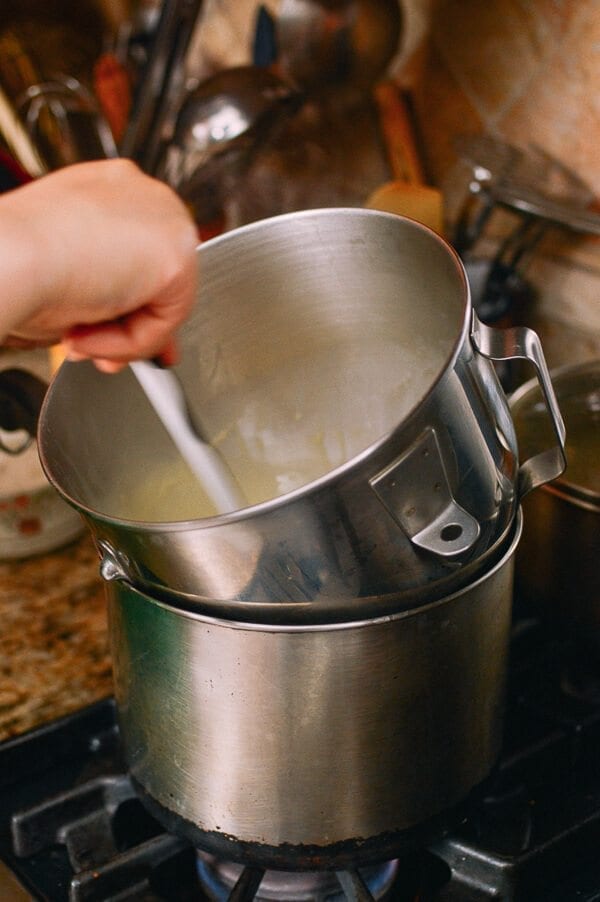 I used a stainless steel mixing bowl, so the egg mixture solidified rather quickly–it took about a minute. It’s essential that you stir quickly in this process. It may take longer if you use a thicker bowl. Once the egg mixture solidifies into a thick custard, remove from the heat. Do not overcook! Let it cool completely, and it’s ready to use.
Cover the custard to prevent it from drying out while you make the dough. Note: If you’d like to make the filling a day or two early, store it in an air-tight container and refrigerate it.
Next, we’ll make the dough:
In a large mixing bowl, dissolve the yeast in ¼ cup of warm water. Let sit for 10-15 minutes until you see yeast bubbles floating on top of the water.
Now add in the flour, powdered sugar, salt, and coconut milk. Turn on the mixture with the dough hook attachment and set it to low, then slowly add in the regular milk, one tablespoon at a time until a dough is formed.
I used a stainless steel mixing bowl, so the egg mixture solidified rather quickly–it took about a minute. It’s essential that you stir quickly in this process. It may take longer if you use a thicker bowl. Once the egg mixture solidifies into a thick custard, remove from the heat. Do not overcook! Let it cool completely, and it’s ready to use.
Cover the custard to prevent it from drying out while you make the dough. Note: If you’d like to make the filling a day or two early, store it in an air-tight container and refrigerate it.
Next, we’ll make the dough:
In a large mixing bowl, dissolve the yeast in ¼ cup of warm water. Let sit for 10-15 minutes until you see yeast bubbles floating on top of the water.
Now add in the flour, powdered sugar, salt, and coconut milk. Turn on the mixture with the dough hook attachment and set it to low, then slowly add in the regular milk, one tablespoon at a time until a dough is formed.
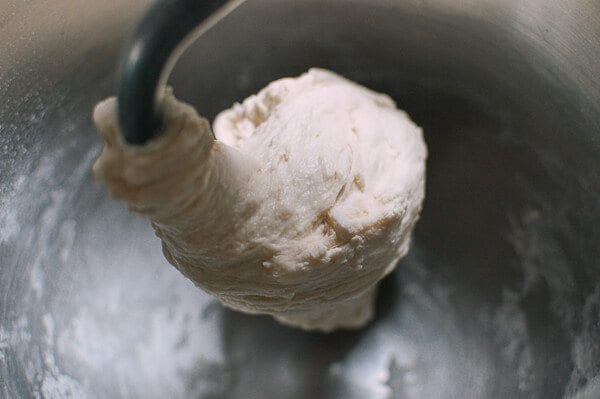 A perfect dough should not stick to your hands or to the bowl–the texture should be smooth like a baby’s bottom!
A perfect dough should not stick to your hands or to the bowl–the texture should be smooth like a baby’s bottom!
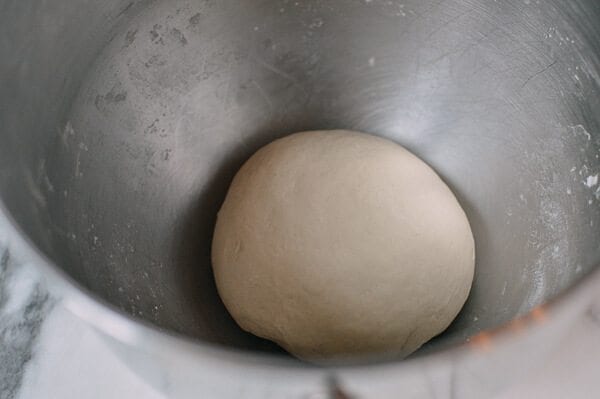 Cover the dough with a dry kitchen towel, and let it proof for 1 hour. I usually proof my dough in my microwave with the door closed and a mug of just-boiled water next to it.
While the dough is proofing, let’s prepare a few things:
Cover the dough with a dry kitchen towel, and let it proof for 1 hour. I usually proof my dough in my microwave with the door closed and a mug of just-boiled water next to it.
While the dough is proofing, let’s prepare a few things:
- Equally divide the egg custard filling into 12 pieces and roll them in your palms to form round balls. Cover them to prevent them from drying out.
- Prepare the steamer. With this recipe, we will start steaming with cold water, so there is no need to pre-boil the water.
- Cut out twelve 4″x4″ pieces of parchment paper. You can also use flattened out cupcake liners, like I have here!
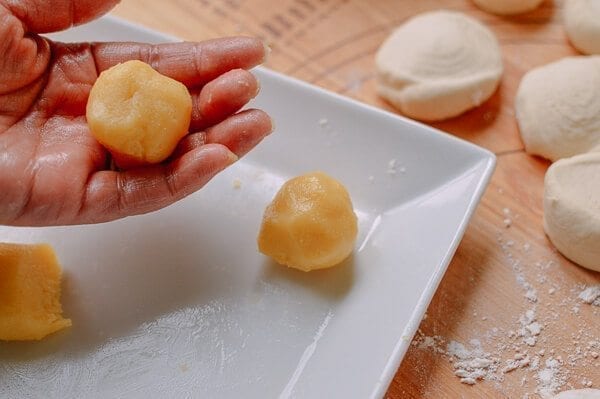 The proofed dough should be about 2½-3 times its original size. Once the dough has finished proofing, put it back in the mixer and let it go for another 2-3 minutes to get rid of any air bubbles.
Now, transfer the dough to a clean and lightly floured surface. With the help of your kitchen scale, equally divide the dough into 12 pieces, and cover with a dry kitchen towel while you assemble the buns.
The proofed dough should be about 2½-3 times its original size. Once the dough has finished proofing, put it back in the mixer and let it go for another 2-3 minutes to get rid of any air bubbles.
Now, transfer the dough to a clean and lightly floured surface. With the help of your kitchen scale, equally divide the dough into 12 pieces, and cover with a dry kitchen towel while you assemble the buns.
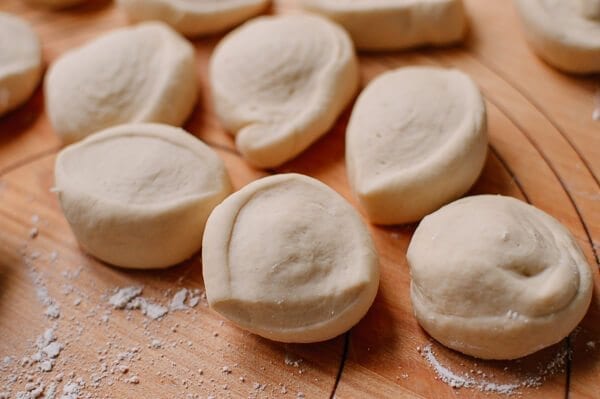 Take one dough ball, roll it out into a 4-inch disc, taking care to make sure the edges are slightly thinner than the center. Put a ball of custard filling on top, pleat, and close the top of the bun–see the video!
Take one dough ball, roll it out into a 4-inch disc, taking care to make sure the edges are slightly thinner than the center. Put a ball of custard filling on top, pleat, and close the top of the bun–see the video!
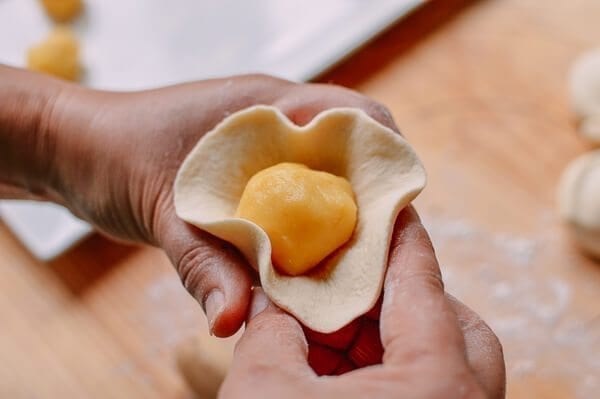
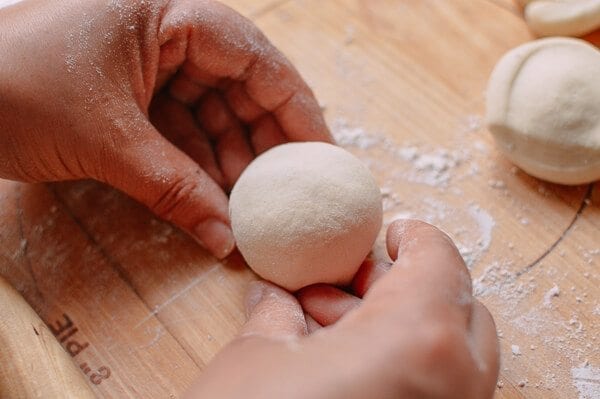 Place it on a piece of pre-cut parchment paper, and set it on your steaming rack. Repeat until all of the buns are assembled. Here’s the video:
Put the buns in the steamer filled with warm water, covered with the lid (do not turn on the heat at this time). Let them sit and proof for another 30 minutes. See our post on how to set up a steamer if you’re not familiar with steaming foods in Chinese cooking.
Place it on a piece of pre-cut parchment paper, and set it on your steaming rack. Repeat until all of the buns are assembled. Here’s the video:
Put the buns in the steamer filled with warm water, covered with the lid (do not turn on the heat at this time). Let them sit and proof for another 30 minutes. See our post on how to set up a steamer if you’re not familiar with steaming foods in Chinese cooking.
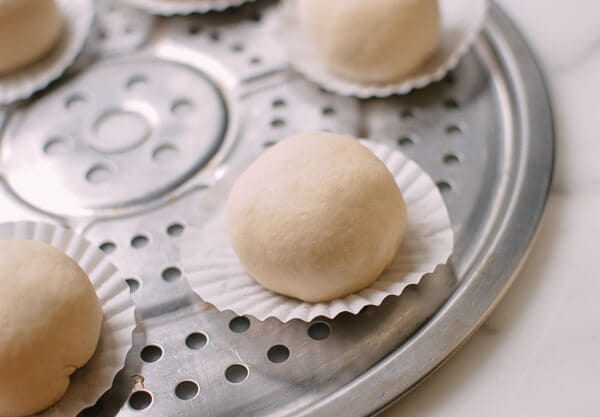 After 30 minutes, turn the heat on and set it to medium. Set your timer for 12 minutes. During these 12 minutes, the medium heat will slowly bring the water to a boil and steam the buns. It may seem slow and lack action at the beginning, but trust me, the buns will be steamed nicely after just 12 minutes.
VERY IMPORTANT NOTE!!! After the 12-minute timer (for steaming) goes off, set the timer for another 5 minutes and turn off the heat. DO NOT UNCOVER THE LID. The buns need about 5 minutes to cool and set or they will collapse, so be patient. They can only be revealed after the 5-minute timer goes off.
After 30 minutes, turn the heat on and set it to medium. Set your timer for 12 minutes. During these 12 minutes, the medium heat will slowly bring the water to a boil and steam the buns. It may seem slow and lack action at the beginning, but trust me, the buns will be steamed nicely after just 12 minutes.
VERY IMPORTANT NOTE!!! After the 12-minute timer (for steaming) goes off, set the timer for another 5 minutes and turn off the heat. DO NOT UNCOVER THE LID. The buns need about 5 minutes to cool and set or they will collapse, so be patient. They can only be revealed after the 5-minute timer goes off.
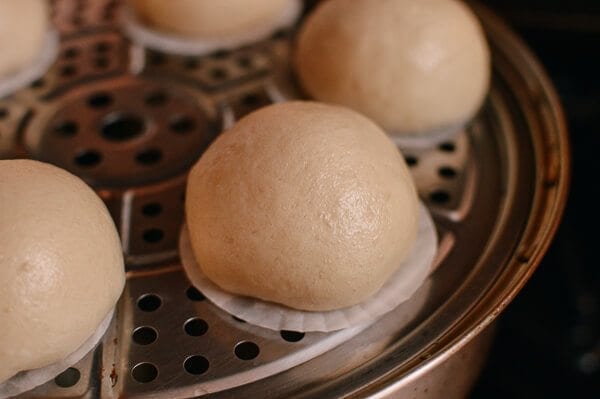 Eat these Cantonese custard buns Nai Wong Bao while they are hot, just like you would if they were straight off the dim sum cart. You can also freeze the leftover buns in a zip-lock bag, and just re-steam when you want to have a bun for a rainy day!
Eat these Cantonese custard buns Nai Wong Bao while they are hot, just like you would if they were straight off the dim sum cart. You can also freeze the leftover buns in a zip-lock bag, and just re-steam when you want to have a bun for a rainy day!
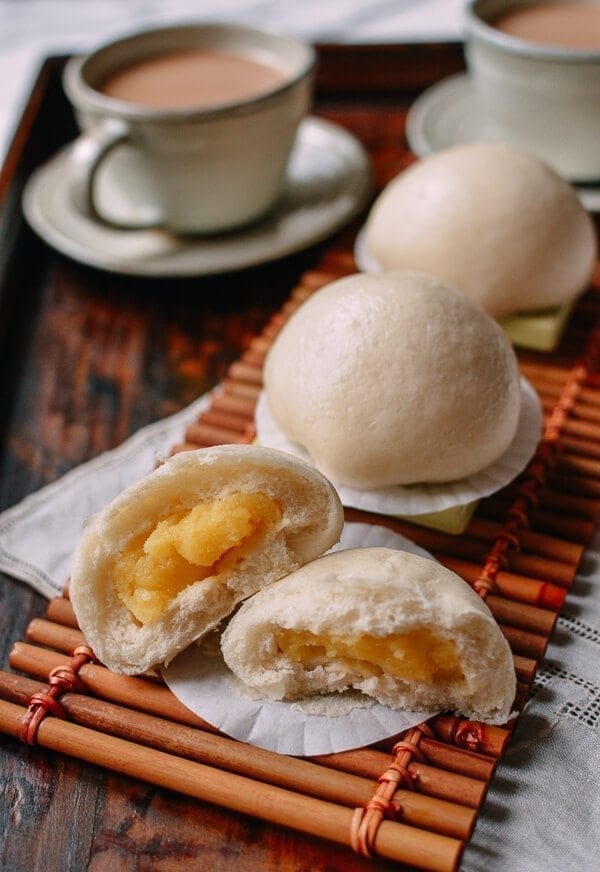
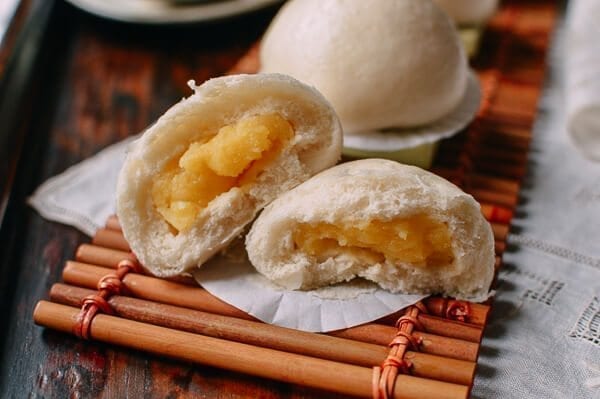
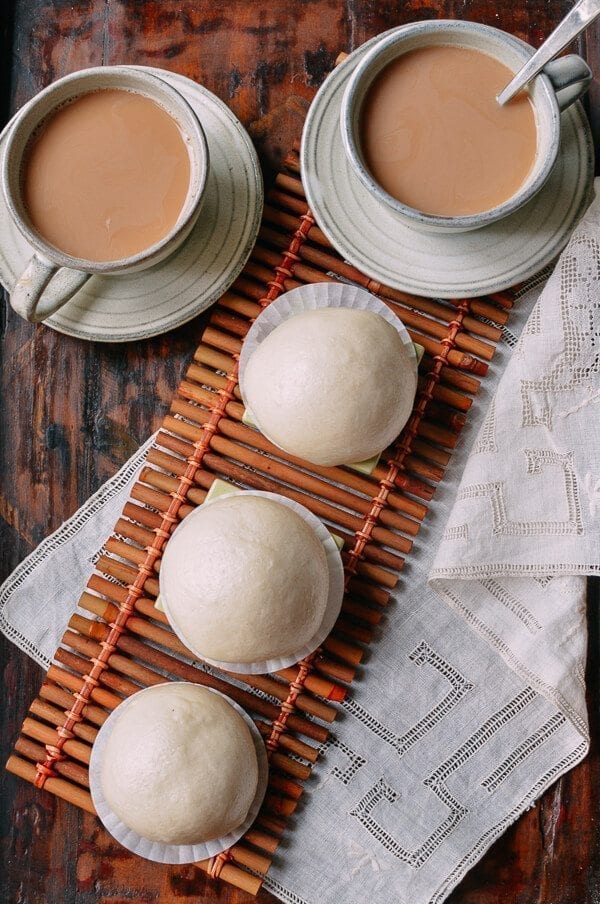
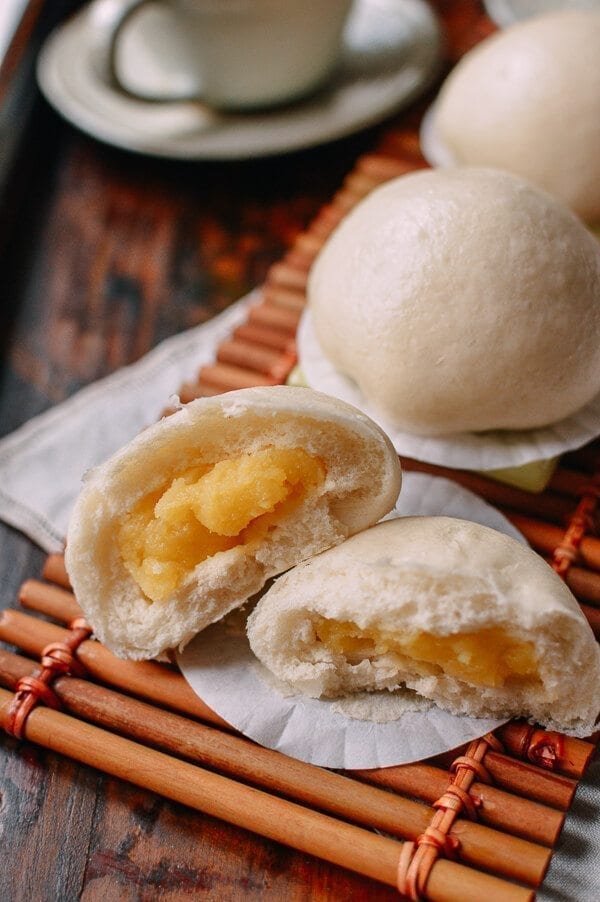
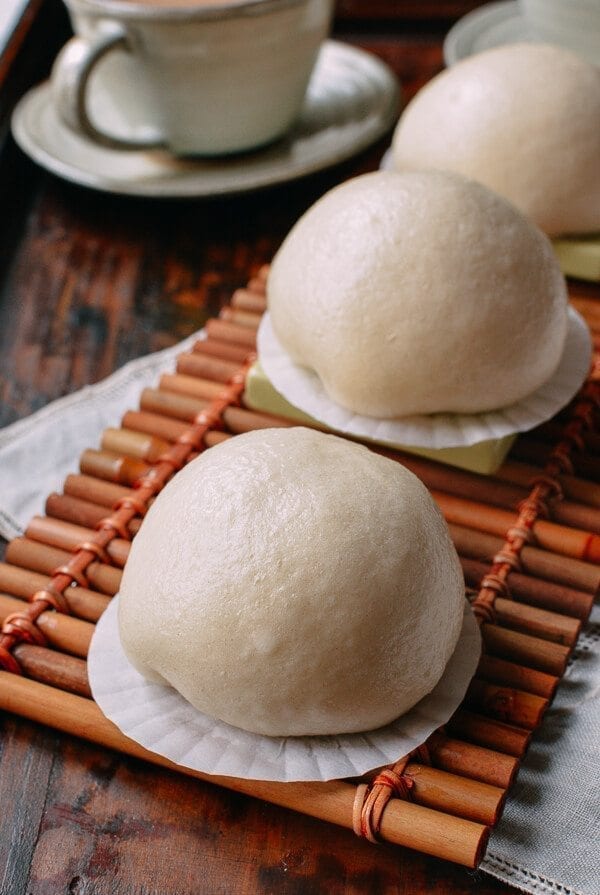
Recipe
Cantonese Steamed Custard Buns (Nai Wong Bao)
These steamed custard buns (nai wong bao) are a Cantonese dim sum favorite. Lightly sweet, creamy custard in a fluffy bun? Pretty much the best treat ever.
Serves: 12
[adthrive-in-post-video-player video-id=”3qmEIdOO” upload-date=”2020-04-11T04:59:13.000Z” name=”Making Nai Wong Bao” description=”making nai wong bao” player-type=”default” override-embed=”default”]
Ingredients
For the filling:
- 2 eggs
- ½ cup powdered sugar (also known as confectioner's sugar or icing sugar, 60g)
- ¼ cup milk (60 ml)
- 3 tablespoons heavy cream (45 ml)
- 3 tablespoons all-purpose flour (25g)
- ¼ cup cornstarch (or wheat starch, 30g)
- ¼ cup dry milk powder (30g)
- 2 tablespoons melted butter (30g)
For the dough:
- 1 teaspoon yeast (2g)
- ¼ cup warm water
- 1½ cups all purpose flour (235 grams)
- 3 tablespoons powdered sugar (22g)
- ¼ teaspoon salt
- 3 tablespoons coconut milk (45 ml)
- 3 tablespoons milk (45 ml, added 1 tablespoon at a time; the quantity may vary depending on humidity)
Instructions
- Start by making the filling. Heat some water in a medium to large, deep pot. The water should be about 2 inches deep, and the pan should be large enough to accommodate the mixing bowl. Once the water boils, turn the heat to down to a simmer.
- In a large heatproof bowl or the metal mixing bowl that came with your stand mixer, add the eggs and powdered sugar. Beat for a minute on low. Next, add the milk and heavy cream, and beat for a few seconds to combine. Then sift in the flour, starch, and dried milk powder. Mix everything in until there are no lumps. Now add in the melted butter, and stir to combine.
- Next, carefully lower the mixing bowl into the pan of water, and begin stirring the mixture quickly and continuously. I used a stainless steel mixing bowl, so the egg mixture solidified rather quickly–it took about a minute. It’s essential that you stir quickly in this process. It may take longer if you use a thicker bowl. Once the egg mixture solidifies into a thick custard, remove from the heat. Do not overcook! Let it cool completely, and it’s ready to use.
- Cover the custard to prevent it from drying out while you make the dough. Note: If you’d like to make the filling a day or two early, store it in an air-tight container and refrigerate it.
- Now make the dough. In a large mixing bowl, dissolve the yeast in ¼ cup of warm water. Let sit for 10-15 minutes until you see yeast bubbles floating on top of the water.
- Now add in the flour, powdered sugar, salt, and coconut milk. Turn on the mixture with the dough hook attachment and set it to low, then slowly add in the regular milk, one tablespoon at a time until a dough is formed. A perfect dough should not stick to your hands or to the bowl–the texture should be smooth like a baby’s bottom!
- Cover the dough with a dry kitchen towel, and let it proof for 1 hour. I usually proof my dough in my microwave with the door closed and a mug of just-boiled water next to it. While the dough is proofing, let’s prepare a few things:
- Equally divide the egg custard filling into 12 pieces and roll them in your palms to form round balls. Cover them to prevent them from drying out. Prepare the steamer. With this recipe, we will start steaming with cold water, so there is no need to pre-boil the water. Cut out twelve 4"x4" pieces of parchment paper.
- The proofed dough should be about 2½-3 times its original size. Once the dough has finished proofing, put it back in the mixer and let it go for another 2-3 minutes to get rid of any air bubbles.
- Now, transfer the dough to a clean and lightly floured surface. With the help of your kitchen scale, equally divide the dough into 12 pieces, and cover with a dry kitchen towel while you assemble the buns. Take one dough ball, roll it out into a 4-inch disc, taking care to make sure the edges are slightly thinner than the center. Put a ball of custard filling on top, pleat, and close the top of the bun–see the video! Place it on a piece of pre-cut parchment paper, and set it on your steaming rack. Repeat until all of the buns are assembled.
- Put the buns in the steamer filled with warm water, covered with the lid (do not turn on the heat at this time). Let them sit and proof for another 30 minutes. After 30 minutes, turn the heat on and set it to medium. Set your timer for 12 minutes. During these 12 minutes, the medium heat will slowly bring the water to a boil and steam the buns. It may seem slow and lack action at the beginning, but trust me, the buns will be steamed nicely after just 12 minutes.
- VERY IMPORTANT NOTE!!! After the 12-minute timer (for steaming) goes off, set the timer for another 5 minutes and turn off the heat. DO NOT UNCOVER THE LID. The buns need about 5 minutes to cool and set or they will collapse, so be patient. They can only be revealed after the 5-minute timer goes off.
- Eat them while they are hot, just like you would if they were straight off the dim sum cart. You can also freeze the leftover buns in a zip-lock bag, and just re-steam when you want to have a bun for a rainy day!
Nutrition Facts
Calories: 167kcal (8%) Carbohydrates: 25g (8%) Protein: 5g (10%) Fat: 5g (8%) Saturated Fat: 3g (15%) Cholesterol: 39mg (13%) Sodium: 97mg (4%) Potassium: 104mg (3%) Fiber: 1g (4%) Sugar: 9g (10%) Vitamin A: 225IU (5%) Vitamin C: 0.2mg Calcium: 52mg (5%) Iron: 1.1mg (6%)





